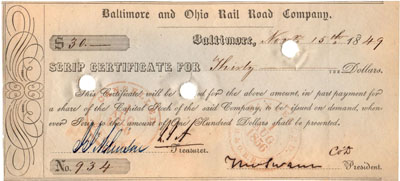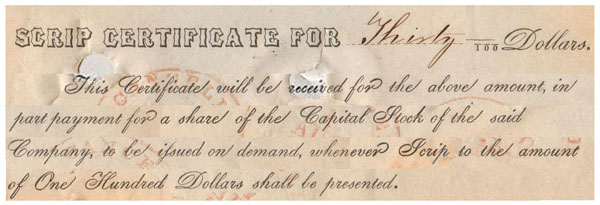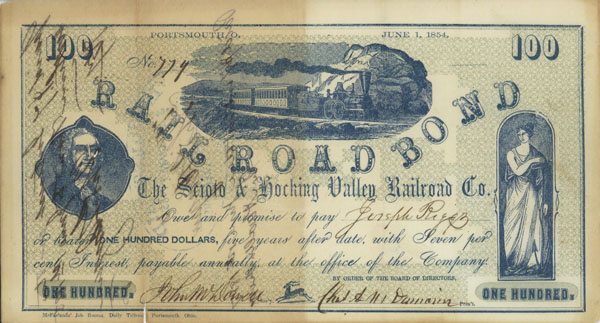Scrip related to stocks and bonds
Scrip is highly diverse

Other than stocks and bonds, "scrip" is probably the most diverse evidence of financial interactions between companies and their investors. In fact, one-fourth of all certificates cataloged in the "other" category are forms of scrip.
Strictly speaking, scrip is a substitute or alternative currency. It is usually a form of credit and most scrip acknowledges or implies an existing debt by the issuer. There are many examples of scrip in this database that represented dividend payments and interest payments that were convertible only by conversion into additional shares or bonds.
"Scrip" can mean different things to collectors in other hobbies. The paper money hobby recognizes scrip as unofficial paper money. The exonumia hobby recognizes non-official coinage as scrip, vast numbers of which were minted by coal companies up and down the length of Appalachia.
Coal company scrip was a de facto form of currency and coinage, but redeemable only in company stores. Some railroad scrip was purposely designed to resemble currency. It tended to circulate as currency within company service areas, but was only occasionally redeemable in U.S. coinage. That type of scrip is considered part of the obsolete currency collecting hobby and is NOT cataloged in this project.
If railroad scrip RESEMBLES PAPER MONEY, then it is usually beyond the bounds of this project.
This project catalogs railroad scrip that most closely resembles stock certificates, security receipts, checks and other non-currency documents. This type of railroad scrip was usually redeemable only by the purchase of shares and bonds and occasionally for transportation-related uses.
The item shown above is a typical example of railroad scrip. It is quite plain and was redeemable only during purchase of more stock. Below is an enlargement of that item with text re-arranged for easier reading. Notice that this type of scrip directly references partial payment for capital stock. (Image courtesy Dr. Thomas O'Shaughnessy)

Railroad currency
Railroad currency has always proven problematic. Many collectors have asked that I catalog railroad currency, similar to the $10 note shown at right. I wish I had the time to do so. However, no matter how much I enjoy railroad currency, I designed the project to deals with stocks and bonds. Scrip that was used as paper money clearly qualifies as obsolete currency and is solidly part of that collecting hobby.
On the other hand...
The item shown below is one of a handful of similar notes that has resulted in some of the most persistent inquiries over the decades. It is clearly a $100 dollar note issued by the Scioto & Hocking Valley Railroad Company. Like many thousands of similar issuances by all manners of businesses during the 1850s and 1860s, notes like this were meant to be tradable for goods and services beyond the railroad company itself. In my opinion, its intent clearly places the item in the obsolete currency hobby.
Notes like this, and a few others, were purposely labeled as "Rail Road Bonds." And therein lies the rub.
This particular note claimed to be a "Rail Road Bond" and promised to pay 7% annual interest five years after date. In other words, the holder should have received $135 in 1859. The "promise to pay" clearly defines this note as a "promissory note." No argument there.

Image courtesy William Knadler
The greater question, though, is whether the word BOND was legitimate. While the distinction might seem an overly fine point to some collectors, promissory notes lack certain security features and therefore do not quality as "bonds." In the case of this particular note:
- There was no stated contractual obligation between issuer and holder.
- There was no remedy stated or implied in the event the issuer defaulted on its promise.
- There was no language that pledged property or other collateral that guaranteed the company's promise.
In my opinion, notes like these were I.O.U.s and nothing more.
For those very reasons, I exclude all promissory notes from this project, regardless of whether they resemble currency or not. Promissory notes printed to resemble currency add to the confusion.
In the case of promissory notes that strong resemble currency, I am forced to apply the "quacks like a duck" rule:
Guiding rationale
If a certificate was made to LOOK like currency and it was meant to CIRCULATE like currency, it WAS currency.
My more formal reasons for excluding currency like this include:
- Railroad currency like the ones shown never offered a contract to holders. Without a "binding" contract for repayment (its "bond" to note holders), no document can be considered a bond regardless of how it might be labeled.
- Auction houses and currency dealers sell railroad currency as part of the paper money hobby. Researching and tracking prices of obsolete currency would be burdensome and take away from the main purpose of this project.
- I firmly believe obsolete railroad currency was printed and issued to circulate as currency.
- Some companies purposely titled some currency as "bonds" in order to take advantage of legal loopholes that legislated which businesses could issue paper money.
Collectors might ask where they can find more information about railroad currency. Unfortunately, I do not know of a guidebook specifically focused on railroad currency, but I hope someone will tell me if there is.
The best reference I know of was a long-running series of articles by Richard T. Hoober titled, Railroad Notes and Scrip of the United States, the Confederate States and Canada. That highly valuable series occupied 107 pages spread over 34 issues of Paper Money published between September, 1983 and November, 1989. Paper Money is the official publication of the Society of Paper Money Collectors. Back issues have been scanned and are available online at Newman Numismatic Portal. While Hoober did not catalog the Scioto & Hocking Valley Railroad Co scrip shown above, he did list a similarly-worded example from the Columbus & Lake Erie Rail Road Co., dated 1850.
Other obsolete currency publications that have touched on railroad scrip include:
- Georgia Railroad Paper: Stock certificates, bonds and currency issued by railroads operating in Georgia 1933-1932 by Gary Eubanks, James Eubanks and Steve Storey (2008, 211 pages, readily available online)
- small single-subject monographs by John A. Muscalus and published by Historical Paper Money Institute. These are not available on the Newman portal but can be found almost continually on eBay and online through used book sellers. Titles include:
- Georgia Railroad Currency Comprehensively Illustrated (1975, 33 pages)
- Mississippi Railroad Currency Comprehensively Illustrated (1977)
- Railroad Currency: Bank notes and scrip representative of over one hundred railroads, 1830's-1900 (1971, 43 pages)